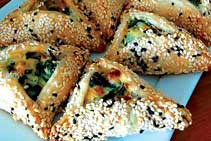I’ll be honest with you. I have never been a big fan of mass produced hamantaschen. I am generally not a sweets guy, but what I always found particularly underwhelming was the thick crust.
When I worked in a bakery in Israel, we would start selling “oznei haman” (Hebrew for haman ears), a month before the holiday. There, halva, caramel, Nutella, poppyseed, and nuts are generally more popular varieties – but most still have that same crust.
One time I came by a bakery (Lachamim on HaHashmonaim Street) with the most visually impressive hamantaschen I had ever seen. Not only did they have the standard sweet varieties, but they also sold savory hamantaschen. But most incredibly, the crusts were so much more delicate and tastier looking. I bought every kind they had, and I couldn’t wait to eat them all.
So, how did hamantaschen become the official food of Purim? According to Stephanie Butnick, deputy editor of Tablet magazine and co-host of the Unorthodox podcast, hamantaschen come from 16th century Germany where Jews took cookies called “mohntaschen” and rebranded them “ha-mohn-taschen” for the holiday. I don’t know what her evidence for that is, but what did they eat before? What most people don’t know is that there is a Levantine dish, which is very similar to hamantaschen except they are savory, called fatayeh. Makes me wonder…
Nevertheless, you might be busy and with limited time to cook, especially for a dessert. That doesn’t mean you can’t create a main dish version. In that case, you could use some wonton/egg roll wrappers as a shell for a savory hamantaschen (search detailed instructions online). The options for fillings are practically endless.
Earlier this month, I filled mine with a seven-spiced hamburger. I dipped them in some hummus and felt nourished both nutritionally and spiritually.
Purim is the only Jewish holiday where the people in Jerusalem add an extra day instead of those living outside the land. Usually, it’s the reverse.
While Israel represents the Jewish people’s cultural home, the country is also a special Jewish blend of all the different cultures we have experienced in the diaspora, and it is this diversity which not only makes Israel at the cutting edge of cultural and economic innovation but also enhances our understanding of our own beliefs.
One of the messages of Purim it is that Jews can have a mixed background and a complicated identity. Our Jewish heritage is a part of us just as is the culture of our host nation, and they are not necessarily in conflict.
Managing the balance can be stressful, so that is one reason we celebrate Purim with some silliness and relief – along with some good food.
Chag Sameach!
Eitan Altshuler operates the Humusyia at the Sandler Family Campus. Its daily menu can be found at the Cardo Cafe.

